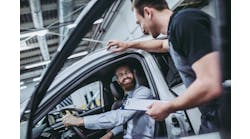David Williams pridefully refers to himself as “just an old body man.” The collision center manager is passionate about his job, and has been virtually throughout a career that began in 1980.
But back in 2000, Williams experienced one of the more irritating stretches of his career. Back then, Williams and his employer, Classic BMW Collision Center in Richardson, Texas, had grown weary of constant suppression of labor rates by insurers. The collision repair center’s direct repair programs (DRPs) had become a hassle.
“The contracts [insurers] wanted us to sign [stipulated] we would use a certain amount of used or aftermarket parts,” Williams recalls. “They kind of pushed you toward repairing panels that might need to be replaced.
“A big issue was the labor rate they wanted to lock us into for a long-term contract. … It just didn’t make sense for us.”
Williams wanted to make certain that his collision repair center fixed cars thoroughly, consistently producing a flawless product. He didn’t want to cut even the slightest corner by using aftermarket or used parts, largely because he didn’t want to disappoint―and potentially lose―longtime customers at the Texas dealership.
And, like many body shop managers, Williams was tired of insurance companies dictating seemingly every element of the repair process.
So, roughly 15 years ago, Williams decided to take a bold step: He would wean his repair facility off all direct repair programs.
“We had enough business that I didn’t feel the need to give concessions away,” the collision center manager recalls. “We made a decision at that point: Let’s capture our own customers.”
The Problem
Classic BMW Collision Center is part of its manufacturer’s certified collision repair center program, and, around the year 2000, Williams began to fear that his facility would get thrown out of the program if it used aftermarket or used parts. Also, the DRPs Williams’ facility had been using―which provided roughly 35 percent of the shop volume―simply weren’t bringing in many new customers in Richardson.
Of course, he also knew that breaking free from DRPs would create battles with insurance adjusters, and would no doubt result in a more drawn-out repair process. Increased expenditures on training likely awaited the shop if it focused more on manufacturer certifications. What’s more, Williams knew he would have to explain to customers exactly why his facility would no longer be mentioned on prefered lists of body shops provided by insurers.
Still, he felt like he had no choice. As in-car technology rapidly evolved, he wanted to make certain that his technicians weren’t pressured to produce hurried repairs. And, ultimately, Williams wanted his staff to have more control over the repair process, rather than have stipulations and demands heaped upon it by insurers.
The Solution
Around 15 years ago, Classic BMW Collision Center said so long to its last DRP program.
Williams viewed it as an opportunity to help his facility stand out from the crowd in the Dallas-Fort Worth metroplex, which is saturated with national chains like Service King and Caliber Collision. The shop sent a letter to every customer that purchased a car from the company. With help from BMW, Williams began sending out full-color mailers, explaining its bold decision with regard to DRPs.
“It’s really educating the customers,” Williams says of his facility’s mail campaign. “It goes over their right to choose a shop, the difference between an OEM, and aftermarket and used parts.”
The staff openly spoke with customers, explaining precisely why the facility wasn’t aligned with DRPs.
Williams explains to customers that, if they bring their BMW to Richardson―whether it be for a hard-hit wreck that the facility gets so often, or following a front-end collision, or for frame work―‘This is what you’re going to get: You’re going to get your car repaired just the way BMW says it has to be repaired. We’re going to fight that battle for you with the insurance company, to make sure your car is repaired and put back the way it was before it was wrecked―and nothing less.’
“Communication with the customer is imperative. … Just keep them informed―show them, on the car or the documentation, ‘Here’s where we sent it, here’s when it got sent, here’s what we asked for, here’s why we asked for it.’”
While the occasional insurance adjuster quarrels with Williams’ staff over necessary repairs, most insurance company employees have eventually come to treat Classic BMW Collision Center reasonably respectably, because of the ample documentation they’re provided when they visit the facility.
The Aftermath
Since breaking free from DRPs, Classic BMW Collision Center has “thrived,” Williams says. And the outlook remains encouraging. These days, the repair facility is consistently booked six weeks out for drivable vehicles. Work largely flows into Richardson via word-of-mouth, referrals, and repeat customers.
“We probably have a new facility in our future, because of the size that we’ve grown,” notes Williams, whose facility has a monthly car count of 250. “We schedule [customer’s repair appointments] out now, and they seem to wait for us. So, we’re doing something right, and it’s growing.”
Classic BMW Collision Center currently has a 21-day cycle time, due in part to the large amount of big wrecks it consistently sees, but also to the longer process of repairing vehicles to manufacturer requirements―and without the relatively prompt approvals from insurers that DRP-affiliated shops typically receive. Despite that cycle time, the Texas facility has increased its annual revenue from $7 million in 2008 to $12 million currently.
“When we eclipsed a million dollars per month without any DRPs, that was probably the biggest ‘a-ha’ moment of my career,” Williams notes.
The Takeaway
Roughly 15 years later, Williams remains confident that he made the right decision by breaking free from DRPs at Classic BMW Collision Center.
“This can be done,” he says. “You just have to stick to your guns, and you have to not allow the insurance company to dictate how you fix a car.”
Williams says the key to surviving without the support of DRPs really boils down to completely transparent communication.
“Being honest with everybody―insurance companies, customers―and doing what you say you’re going to do, that pays off in the long run,” he says.




